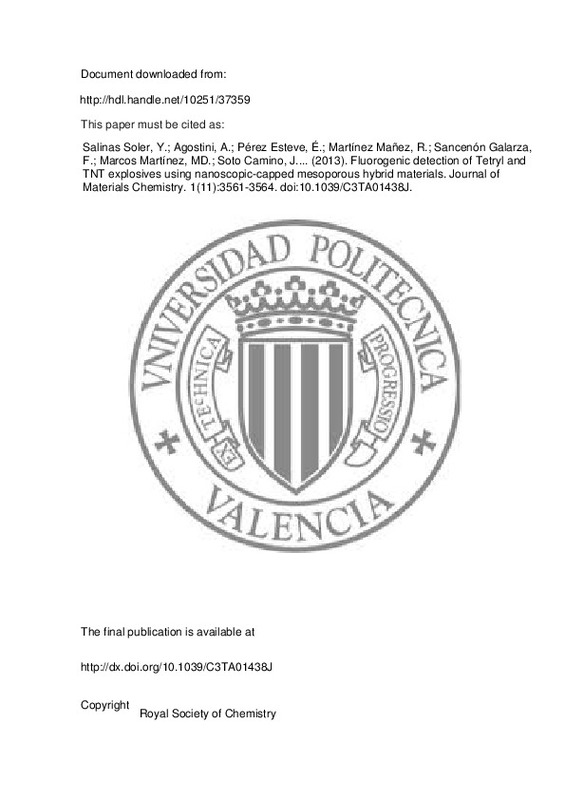Singh, S. (2007). Sensors—An effective approach for the detection of explosives. Journal of Hazardous Materials, 144(1-2), 15-28. doi:10.1016/j.jhazmat.2007.02.018
Schulte-Ladbeck, R., Vogel, M., & Karst, U. (2006). Recent methods for the determination of peroxide-based explosives. Analytical and Bioanalytical Chemistry, 386(3), 559-565. doi:10.1007/s00216-006-0579-y
Smith, R. G., D’Souza, N., & Nicklin, S. (2008). A review of biosensors and biologically-inspired systems for explosives detection. The Analyst, 133(5), 571. doi:10.1039/b717933m
[+]
Singh, S. (2007). Sensors—An effective approach for the detection of explosives. Journal of Hazardous Materials, 144(1-2), 15-28. doi:10.1016/j.jhazmat.2007.02.018
Schulte-Ladbeck, R., Vogel, M., & Karst, U. (2006). Recent methods for the determination of peroxide-based explosives. Analytical and Bioanalytical Chemistry, 386(3), 559-565. doi:10.1007/s00216-006-0579-y
Smith, R. G., D’Souza, N., & Nicklin, S. (2008). A review of biosensors and biologically-inspired systems for explosives detection. The Analyst, 133(5), 571. doi:10.1039/b717933m
Moore, D. S. (2004). Instrumentation for trace detection of high explosives. Review of Scientific Instruments, 75(8), 2499-2512. doi:10.1063/1.1771493
H�kansson, K., Coorey, R. V., Zubarev, R. A., Talrose, V. L., & H�kansson, P. (2000). Low-mass ions observed in plasma desorption mass spectrometry of high explosives. Journal of Mass Spectrometry, 35(3), 337-346. doi:10.1002/(sici)1096-9888(200003)35:3<337::aid-jms940>3.0.co;2-7
Wallis, E., Griffin, T. M., Popkie, Jr., N., Eagan, M. A., McAtee, R. F., Vrazel, D., & McKinly, J. (2005). Instrument response measurements of ion mobility spectrometers in situ: maintaining optimal system performance of fielded systems. Chemical and Biological Sensing VI. doi:10.1117/12.609920
Germain, M. E., & Knapp, M. J. (2009). Optical explosives detection: from color changes to fluorescence turn-on. Chemical Society Reviews, 38(9), 2543. doi:10.1039/b809631g
Forzani, E. S., Lu, D., Leright, M. J., Aguilar, A. D., Tsow, F., Iglesias, R. A., … Tao, N. (2009). A Hybrid Electrochemical−Colorimetric Sensing Platform for Detection of Explosives. Journal of the American Chemical Society, 131(4), 1390-1391. doi:10.1021/ja809104h
Salinas, Y., Martínez-Máñez, R., Marcos, M. D., Sancenón, F., Costero, A. M., Parra, M., & Gil, S. (2012). Optical chemosensors and reagents to detect explosives. Chem. Soc. Rev., 41(3), 1261-1296. doi:10.1039/c1cs15173h
Thomas, S. W., Joly, G. D., & Swager, T. M. (2007). Chemical Sensors Based on Amplifying Fluorescent Conjugated Polymers. Chemical Reviews, 107(4), 1339-1386. doi:10.1021/cr0501339
Gao, D., Wang, Z., Liu, B., Ni, L., Wu, M., & Zhang, Z. (2008). Resonance Energy Transfer-Amplifying Fluorescence Quenching at the Surface of Silica Nanoparticles toward Ultrasensitive Detection of TNT. Analytical Chemistry, 80(22), 8545-8553. doi:10.1021/ac8014356
Zhang, S., Lü, F., Gao, L., Ding, L., & Fang, Y. (2007). Fluorescent Sensors for Nitroaromatic Compounds Based on Monolayer Assembly of Polycyclic Aromatics. Langmuir, 23(3), 1584-1590. doi:10.1021/la062773s
Hughes, A. D., Glenn, I. C., Patrick, A. D., Ellington, A., & Anslyn, E. V. (2008). A Pattern Recognition Based Fluorescence Quenching Assay for the Detection and Identification of Nitrated Explosive Analytes. Chemistry - A European Journal, 14(6), 1822-1827. doi:10.1002/chem.200701546
Vijayakumar, C., Tobin, G., Schmitt, W., Kim, M.-J., & Takeuchi, M. (2010). Detection of explosive vapors with a charge transfer molecule: self-assembly assisted morphology tuning and enhancement in sensing efficiency. Chemical Communications, 46(6), 874. doi:10.1039/b921520d
Salinas, Y., Climent, E., Martínez-Máñez, R., Sancenón, F., Marcos, M. D., Soto, J., … Pérez de Diego, A. (2011). Highly selective and sensitive chromo-fluorogenic detection of the Tetryl explosive using functional silica nanoparticles. Chemical Communications, 47(43), 11885. doi:10.1039/c1cc14877j
Climent, E., Martínez-Máñez, R., Sancenón, F., Marcos, M. D., Soto, J., Maquieira, A., & Amorós, P. (2010). Controlled Delivery Using Oligonucleotide-Capped Mesoporous Silica Nanoparticles. Angewandte Chemie International Edition, 49(40), 7281-7283. doi:10.1002/anie.201001847
Climent, E., Marcos, M. D., Martínez-Máñez, R., Sancenón, F., Soto, J., Rurack, K., & Amorós, P. (2009). The Determination of Methylmercury in Real Samples Using Organically Capped Mesoporous Inorganic Materials Capable of Signal Amplification. Angewandte Chemie International Edition, 48(45), 8519-8522. doi:10.1002/anie.200904243
Climent, E., Bernardos, A., Martínez-Máñez, R., Maquieira, A., Marcos, M. D., Pastor-Navarro, N., … Amorós, P. (2009). Controlled Delivery Systems Using Antibody-Capped Mesoporous Nanocontainers. Journal of the American Chemical Society, 131(39), 14075-14080. doi:10.1021/ja904456d
Cabrera, S., El Haskouri, J., Guillem, C., Latorre, J., Beltrán-Porter, A., Beltrán-Porter, D., … Amorós *, P. (2000). Generalised syntheses of ordered mesoporous oxides: the atrane route. Solid State Sciences, 2(4), 405-420. doi:10.1016/s1293-2558(00)00152-7
Kolb, H. C., Finn, M. G., & Sharpless, K. B. (2001). Click Chemistry: Diverse Chemical Function from a Few Good Reactions. Angewandte Chemie International Edition, 40(11), 2004-2021. doi:10.1002/1521-3773(20010601)40:11<2004::aid-anie2004>3.0.co;2-5
Felix, F., Ferguson, J., Guedel, H. U., & Ludi, A. (1980). The electronic spectrum of tris(2,2’-bipyridine)ruthenium(2+). Journal of the American Chemical Society, 102(12), 4096-4102. doi:10.1021/ja00532a019
Lytle, F. E., & Hercules, D. M. (1969). Luminescence of tris(2,2’-bipyridine)ruthenium(II) dichloride. Journal of the American Chemical Society, 91(2), 253-257. doi:10.1021/ja01030a006
[-]







![[Cerrado]](/themes/UPV/images/candado.png)


